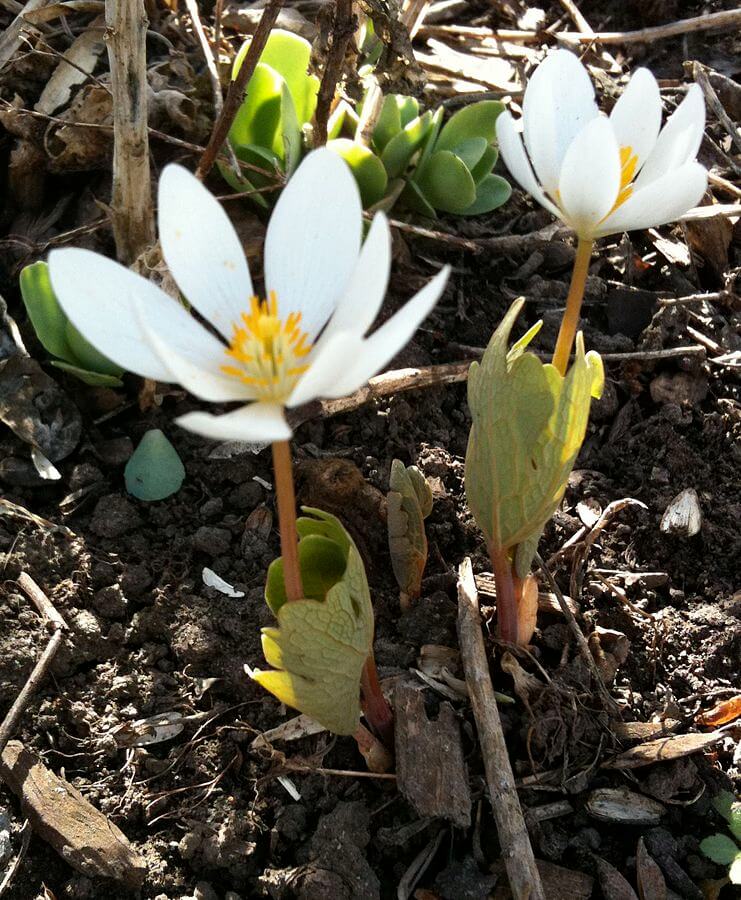
America’s eastern native plants are a national treasure. They also offer a wealth of material for American gardens. This is perhaps most evident in spring, when many of the most beautiful native wildflowers strut their stuff in our fields, forests, or perennial borders.
Bloodroot

Among the first of these to bloom is one of the queens of the Eastern forest, bloodroot (Sanguinaria canadensis). Its broad, scalloped, kidney-shaped leaves unfurl in early spring, sending forth dainty, white, short-stemmed flowers that shatter within a few days of opening. Far longer lasting, however, are the breathtaking double blooms of the cultivar ‘Multiplex’, whose sublime form would do the finest waterlily proud. In whatever form, bloodroot makes a wonderful subject for massing and naturalizing in dappled shade. A moist, relatively coarse soil suits it best (amend heavy or sandy soils with a good compost such as Fafard Premium Natural & Organic Compost).
Virginia Bluebells

Another first-rate naturalizer for moist shade, Virginia bluebells (Mertensia virginica) sends up clusters of nodding, long-necked bell-flowers that morph from pale pink to summer-sky-blue upon opening in early- to mid-spring. The 15- to 18-inch-tall plants are well furnished with broad, blue-dusted leaves that tone prettily with the flowers. As bloom fades, so does the rest of the plant, yellowing and dwindling to a thick fleshy rootstock in late spring. Colonies of seedlings often follow. Wild-collected roots and plants of Virginia bluebell are sometimes sold by disreputable dealers, so buyer beware.
Celandine Poppy

With its sunny yellow mid-spring flowers and penchant for self-sowing, celandine poppy (Stylophorum diphyllum) makes an excellent shade-garden companion for Virginia bluebells. The 2-inch-wide, crepe-textured, four-petaled poppies are borne atop 18-inch clumps of bold foliage with oakleaf-shaped lobes. Bristly seedpods resembling miniature gourds ripen in late spring, with dormancy (and enthusiastic self-sowing) ensuing. Both celandine poppy and Virginia bluebells work well with other, more persistent woodlanders (such as ferns and Solomon’s seal) that fill the gaps left by their early exit.
Woodland Phlox
Although many native woodland perennials die back after blooming in spring, some stay around for the long haul. These include two species of Phlox that make excellent subjects for borders or naturalistic plantings. Woodland phlox (Phlox divaricata) produces drifts of fragrant, five-petaled blooms on wiry, foot-tall stems with paired, pointed leaves. The flowers are typically periwinkle-blue, but white, violet, and other colors occur in the wild and in cultivation. Their form and hue combine effectively with Virginia bluebells, celandine poppy, white trilliums, wild geraniums, and other wildflowers that bloom in mid-spring. After flowering, plants persist through the growing season and beyond as low semi-evergreen hummocks.
Crested Iris
Yet another splendid spreader for partial shade, crested iris (Iris cristata) grows from knobbly rhizomes that walk along the soil surface, like a bearded iris in miniature. Fanned tufts of arching, 6-inch, blade-shaped leaves give rise to proportionately large blooms that slightly over top the foliage in mid-spring. Flower color ranges from violet-blue to white, with contrasting yellow and white markings. Several cultivars are available. A lightly shaded site with moist, fertile, relatively porous soil is ideal.
All of these – and many more besides (including Geranium maculatum, Hepatica acutiloba, Trillium grandiflorum, Delphinium tricorne, Tiarella cordifolia, Polemonium reptans, and Uvularia grandiflora) – are essential plants for any eastern North American garden that seeks to embody a sense of place.











